I am working with a spatial dataset where the response is binary 0 or 1. I want to estimate the beta coefficients and account for the spatial autocorrelation, so am trying to fit a binomial regression model using the CARBayes package S.CARleroux with family="binomial". However, sometimes when I do this it works and the result is a distribution for the coefficients, but with other datasets (formatted the same way) the trace plots remain flat and there the effective sample number n.effective is 0.
For example, in this case, it appears that the sampling was working, and then essentially failed:

Other times, again with very similar datasets, the result is 
The code I'm using is: car.prox <- S.CARleroux(formula=f, data = df, W=W, family="binomial",burnin=burn.in, n.sample=n.sample,thin=20, trials=rep(1,nrow(df)), rho = 1, verbose=TRUE)
The output, in the second case, is
#################
#### Model fitted
#################
Likelihood model - Binomial (logit link function)
Random effects model - Leroux CAR
Regression equation - y ~ var2 + var3 + var4 + var5 + var6 +
var7 + var8 + var9 + var10
Number of missing observations - 0
############
#### Results
############
Posterior quantities and DIC
Median 2.5% 97.5% n.sample % accept n.effective
(Intercept) -12.2061 -12.2061 -12.2061 10000 0.8 0.0
var2 -1.7098 -1.7098 -1.7098 10000 0.8 0.0
var3 6.2169 6.2169 6.2169 10000 0.8 0.0
var4 21.3834 21.3834 21.3834 10000 0.8 0.0
var5 -8.3727 -8.3727 -8.3727 10000 0.8 0.0
var6 7.8046 7.8046 7.8046 10000 0.8 0.0
var7 2.3668 2.3668 2.3668 10000 0.8 0.0
var8 -8.7651 -8.7651 -8.7651 10000 0.8 0.0
var9 -1.0197 -1.0197 -1.0197 10000 0.8 0.0
var10 -3.6726 -3.6726 -3.6726 10000 0.8 0.0
tau2 11022.7758 10122.9703 12068.6439 10000 100.0 4420.2
rho 1.0000 1.0000 1.0000 NA NA NA
Geweke.diag
(Intercept) NaN
var2 NaN
var3 NaN
var4 NaN
var5 NaN
var6 NaN
var7 NaN
var8 NaN
var9 NaN
var10 NaN
tau2 -2.3
rho NA
DIC = NaN p.d = NaN LMPL = -2871.75
How can I fix this and get the distribution for the coefficients in a way that accounts for the spatial autocorrelation?
Reproducible example:
# libraries
library(CARBayes)
library(Matrix)
# data as txt can be copied from https://gist.github.com/tommlogan/584f235f60bb05b5ae57e0d7e44b7aee
# there are dput options and .txt options
df <- read.table('atl_data.txt')
W <- readMM(file='atl_neighbors.txt')
W <- as(W, 'matrix')*1
# parameters
burn.in <- 50000 #100000
n.sample <- 150000 # 300000
thin.n <- 20
explan_vars = c('black','asian','amindian','hispanic','youth','aged','poverty','density','female')
# Now we fit the model to three different response variables in the same dataset and see the output changes
# this first one at least samples randomly (the trace plots are suitable)
f <- as.formula(paste("class_prox~", paste(explan_vars, collapse=" + ")))
car.lm <- S.CARleroux(formula=f, data = df, W=W, family="binomial",burnin=burn.in, n.sample=n.sample,thin=thin.n, trials=rep(1,nrow(df)), rho = 1, verbose=TRUE)
print(car.lm)
plot(car.lm$samples$beta)
# in this example the trace plots initially indicate variation in the samples, but then it flatlines at a constant value
f <- as.formula(paste("class_crime~", paste(explan_vars, collapse=" + ")))
car.lm <- S.CARleroux(formula=f, data = df, W=W, family="binomial",burnin=burn.in, n.sample=n.sample,thin=thin.n, trials=rep(1,nrow(df)), rho = 1, verbose=TRUE)
print(car.lm)
plot(car.lm$samples$beta)
# in this example the trace plots are a constant value the entire time
f <- as.formula(paste("class_cong~", paste(explan_vars, collapse=" + ")))
car.lm <- S.CARleroux(formula=f, data = df, W=W, family="binomial",burnin=burn.in, n.sample=n.sample,thin=thin.n, trials=rep(1,nrow(df)), rho = 1, verbose=TRUE)
print(car.lm)
plot(car.lm$samples$beta)